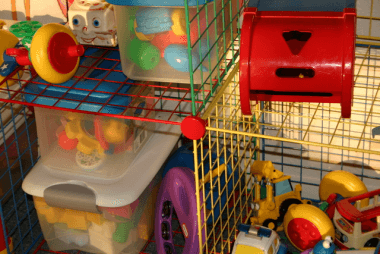The wholesale (maybe I should say “retail”) celebration of consumerism makes a lot of people anxious, with good reason. What kind of values are we modeling for our children when we embrace consumption so greedily during the Christmas season? And yet, children outgrow toys. Their tastes change, their abilities change, and what was appropriate last year has little to offer them next year. Unless we’re ready to embrace a toy-free childhood for our kids, I think we have to accept the yearly churn of toys, and Christmas is as good a time as any to do the turn-over. But we do not have to accept the blind consumerism that often comes along with it. Christmastime offers an opportunity to teach children important lessons about consumption, by instituting a yearly ritual that starts with cleaning up their room. The idea is simple: set aside a day this weekend or next, as the Christmas season pitches into full gear, to work with your children on cleaning their rooms. This isn’t a normal room-cleaning, though. Explain to them that while they are dreaming of new toys for Christmas, there are lots of kids whose families can’t afford to give their children new toys, and that those children would be happy to have some of your kids’ toys to play with. Set out two boxes, one for trash and one for charity, and sort their old toys into them. As you pick up each toy in their room, ask them whether they think they will still play with it next year. Then ask whether another child might enjoy it more than they would. If they aren’t playing with it anymore, or if they can bear to part with it, it goes in one of the two boxes. Which box is for you and our child to decide. If you have young children, this is an opportunity to teach them something of the quality of things — what it means for something to be working or not working, whole or broken. You might also be able to make a point about taking care of their things — if a toy is something they would still play with if it wasn’t broken, talk about how they might have protected it better. Broken toys go in the trash box, and whole toys go in the charity box. You might have to second-guess a few of your children’s decisions, but for the most part, you should follow their lead. If you take too much of the decision-making responsibility out of their hands, they will start to see giving as a kind of punishment, which is obviously not the goal. For each toy they choose to keep, ask them where they think it should be kept in their room. Help them decide on a realistic strategy for organizing their stuff (and keeping it organized) — even if the neatness doesn’t last, the lessons of categorizing and organizing will. There are a number of benefits to this beyond just getting their rooms clean in time for the arrival of Santa’s deliveries. Making this kind of clean-sweep teaches:
Organization: Kids tend to have short attention spans and aren’t mentally equipped to always consider the consequences of their actions, so it might be too much to ask that they keep things organized, but they still have to be taught how to organize if they’re ever going to learn. Getting them to categorize their toys — “keep”, “give”, “throw out” — helps them develop the mental capacities to understand why things have places in which they belong. Charity: Teaching children to take responsibility for giving also helps teach them to take responsibility for others and to recognize their own relative privilege. Empathy: Children — heck, many adults, too — have a hard time imagining the way that their lives differ from other people’s lives. Getting them to imagine a life without their favorite toys, or a life without a gift-bedecked Christmas tree, helps them learn to put themselves in someone else’s shoes — an important lesson for almost every aspect of their later lives. Contemplation: Getting into the habit of annually reviewing one’s possessions and their meaning helps counteract the raw consumerism that surrounds us at Christmastime. It teaches children to look at themselves and their lives — again, an important lesson for a balanced adulthood. Counter-consumerism: I’m not preaching anti-consumerism, here — it’s pretty much inevitable that our children’s lives will be shaped by consumerism. But we can teach them to create a critical and reflective relationship with their own consumption, so that they learn to build identities that are not determined by what they buy. Thinking about the relationship between need and possession — e.g. “Do I want this toy because I actually play with it or just because it’s mine?” — can help put them on that path.
After filling up your charity box (or boxes), load them in the car and take them to a local charity with your children. You might have todo a little research to decide where to give your toys — things that are new and in their packages can go to Toys for Tots, toys that are not new but are still in good shape can go to a local shelter, religious organization, or other relief organization. Thrift stores like Goodwill and Salvation Army sell toys to raise money for their other activities, which means that you cannot be sure a needy child will benefit from your children’s charity, but if you can’t find anything else locally, they are a fine last alternative. With an afternoon’s work — and family togetherness, which is nothing to sneeze at! — you can teach some valuable lessons to your children and help out someone else’s children at the same time. And, if nothing else, you’ll have cleared up some space in their rooms for the new arrivals come Christmas.
